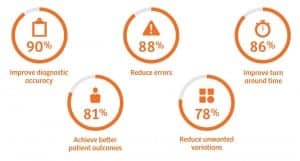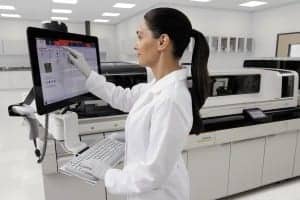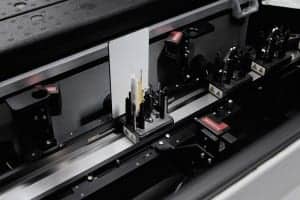Artificial intelligence promises to deliver both better business and clinical outcomes
By Deepak Nath, PhD
The healthcare sector consistently implements innovative technological breakthroughs that improve diagnostic accuracy, advance patient care, and optimize clinical operations. The continuous evolution of in vivo and in vitro diagnostic testing has helped to improve the lives of millions of patients and the productivity of healthcare providers globally.
Yet disruptive technologies are often met with equal parts trepidation and optimism. Whether facing opposition to replacing well-understood and established practices or concerns about automation increasingly displacing human intellect and judgment, innovators have needed to identify and mitigate risk factors to overcome resistance and barriers to adoption.

Figure 1. Current level of clinical laboratory engagement with artificial intelligence, according to respondents to a 2018 survey commissioned by Siemens Healthineers.
Clinical laboratories are on the brink of another transformative change: the integration of artificial intelligence (AI) into the diagnostic process. Just as for the technologies that preceded it, the lab sector is both excited and cautious about the changes that AI will bring to the laboratory (Figure 1). To garner support for deployment, laboratory management must demonstrate to stakeholders the enormous potential of AI and its value to both patients and healthcare institutions. Clearing the path for implementation is a critical objective if labs are to be enabled by AI to help deliver both better business and clinical outcomes.
But in the current state of knowledge, it is understandable that laboratory management wants to know more about what an AI-driven healthcare future will look like for the laboratory sector, and how AI can best be deployed in clinical laboratories. To answer these questions, Siemens Healthineers, Tarrytown, NY, commissioned a survey of 200 hospital and laboratory senior executives and lab directors (Figure 2). This article summarizes some of the key responses to the survey in the context of issues affecting the adoption of AI in clinical labs.
Volume, Staffing, and Financial Pressures
Test volume continues to rise due to a growing and aging population, continuous introduction of new lab tests, and more preemptive approaches to healthcare and disease-state management.

Figure 2. Characterization of respondents to the 2018 survey on the future of artificial intelligence in clinical laboratories, commissioned by Siemens Healthineers and carried out by ReRez Research, Dallas.
However, growth is harder to achieve when labs are already facing a shortage of skilled professionals to meet existing workloads. The US Bureau of Labor Statistics predicted 18,000 clinical laboratory science program vacancies by 2018, but only 5000 students are graduating from accredited programs each year.1 This means that the educational institutions preparing tomorrow’s laboratory workforce are delivering less than a third of the people needed. Compounding this challenge, the American Society for Clinical Pathology reports that 7.5% of lab jobs are vacant, and 20% of current staff are expected to retire in the next 5 years.2
In the United States, the new fee schedule of the Centers for Medicare and Medicaid Services (CMS) will introduce cuts of up to 30% over the next couple of years.3 In order for a laboratory to be competitive and generate revenue sufficient to offset such reimbursement cuts, laboratory directors must both reduce costs and identify new growth opportunities. Faced with such cost and staffing pressures, laboratories must increase their workforce productivity and optimize their clinical operations by extracting as much benefit as possible from automation, diagnostics information technologies (IT), and artificial intelligence.

Figure 3. Objectives of artificial intelligence in the clinical laboratory, according to respondents to the 2018 survey commissioned by Siemens Healthineers.
Implementing artificial intelligence throughout diagnostic processes will quickly become important for labs to help support increased workloads with fewer staff. While AI has incredible potential for analysis and diagnosis, the majority of time and effort in a lab is spent on pre- and postanalytical processes. AI has the potential to bring significant improvements to workflow and operations, saving time, labor, and costs. Among the lab executives surveyed by Siemens Healthineers86% responded that faster turnaround times are critical, 76% prioritize optimizing clinical operations, and 62% identify increased workforce productivity as a top objective (Figure 3).
The executives also identified improved diagnostic performance as a core focus for laboratories, with 90% listing diagnostic accuracy, 88% specifying error reduction, and 78% seeking to limit unwarranted variations throughout their operations.
AI Implementation and Goals
With all these challenges foremost in their minds, the surveyed lab directors envision a future in which AI is integrated throughout the lab—and this future is approaching quickly. Among the survey respondents, 69% anticipate that AI will be implemented in the in vitro diagnostics (IVD) lab within 4 years. To prepare, decisionmakers at both the industry and enterprise levels should already be mapping out a smooth and efficient AI implementation plan (Figure 4).

Figure 4. Although most clinical labs believe that artificial intelligence will have an important impact on their operations, the 2018 survey commissioned by Siemens Healthineers found that few labs have a clear idea of how to begin implementing artificial intelligence.
Since the lab generates much of the data that feeds AI’s decisionmaking, lab IT systems will need to be part of an enterprisewide digital ecosystem that provides an open and secure framework for aggregating, analyzing, and operationalizing this data. Industry and organization leaders will need to work together to facilitate the move toward accessible, interoperable, curated, and standardized data sources as the foundation of AI systems (Figure 5). Such data will enable AI to provide insights, create comprehensive models, and identify diagnostic patterns that will aid human technicians in providing the best patient care. To protect patient information, operations, and IT systems, cybersecurity and data privacy must be of paramount importance and should be an integral part of system and process design.
Survey respondents highlighted three key areas where AI in the laboratory is anticipated to make a difference. First, AI is expected to improve diagnostic accuracy and consistency by reducing human error and unwarranted variation. Second, with access to large sources of standardized data, AI is expected to identify previously undiscovered patterns that will help refine treatment pathways and identify common risk factors of chronic diseases, which can lead to prevention of illness. Finally, by eliminating repetitive, manual tasks, AI can enable skilled laboratory professionals to focus their expertise on work that requires the human element, such as specialty testing or interpreting complex results.
AI Capabilities in Practical Applications
To augment the intellectual work of experts, AI helps to systematize analysis and decisionmaking. Neural networks are complex algorithms intended to emulate human thought processes, with the ability to process massive amounts of data in an instant: analyzing, interpreting, and classifying patient samples, images, and data.

Figure 5. The Atellica Solution by Siemens Healthineers incorporates data handling capabilities that support the development of an artificial intelligence environment in the clinical lab.
Currently available to labs outside the United States, the Atellica 1500 Automated Urinalysis System uses high-resolution digital microscopy to capture images of patient samples. The system then processes these images using a real-time neural network trained with a database of more than 110,000 sedimentation images to provide instantaneous particle identification, minimizing the need for arduous and time-consuming manual microscopy.
Beyond the analytical process and diagnostic decisionmaking, AI can also be applied to improving operations and streamlining workflow.
When an analyzer goes down unexpectedly, it has a cascading effect on operations. Staff must be pulled away from routine tasks to identify and resolve the issue. Unscheduled downtime is inefficient, costly, and stressful. It takes an average of approximately 30 minutes for an operator to identify that there is a problem that he or she cannot solve, and for every 30-minute increase in test turnaround time, patient stays are extended by 17 minutes.4
The Atellica Solution also incorporates AI within its multicamera vision systems, which can instantly identify and characterize each tube based on data ‘learned’ from more than 60,000 containers (Figure 6). The cameras detect sample container parameters to dynamically adjust routing and stat prioritization, tube handling, and aspiration position, to meet the unique needs of each tube (Figure 7). The system automatically determines special handling needs—such as for tube-top sample cups or precious pediatric samples—to better preserve the integrity of delicate samples and reduce the need for manual presorting. As stat samples are recognized, they are prioritized, and routine specimens are moved out of the way via the bidirectional Magline transport technology, providing rapid access to critical results.

Figure 6. The Atellica Solution’s artificial intelligence vision system can instantly identify and characterize each sample tube, based on data ‘learned’ from more than 60,000 containers.
Siemens Healthineers is continuing its investment in innovation with development of the AI-Pathway Companion, a next-generation AI-based clinical decision support system with a key design goal of providing clinicians in multidisciplinary disease boards with the clinical status of each patient. The goal for the system is to aggregate the patient’s history using results from imaging, laboratory, pathology, and genetic testing, and the data from clinical studies. It will then analyze the data in whole and use it as the basis for establishing the patient’s status in the clinical pathway, taking clinical guidelines into account, and for suggesting next steps.5 The AI-Pathway Companion is currently under development, and is not yet available in the United States.
Barriers to AI Implementation
With all the potential of AI for clinical laboratories, key stakeholders still express concerns when it comes to implementing AI.
Among the survey respondents, 81% cited regulatory concerns surrounding the emerging AI technology. Regulators recognize the potential for AI and are actively exploring how to balance patient safety and confidentiality while supporting innovation. For example, FDA has introduced a digital health innovation action plan to foster innovation while continuing to protect public safety.6

Figure 7. The Atellica Solution’s three-camera vision system automatically determines special handling needs for each sample tube.
Perhaps it is not surprising that 88% of the executives and lab directors surveyed responded that they are worried about the investment required to purchase new instruments and technology, as well as the time and expense of training. As with any cost-benefit analysis, it will be crucial for lab leaders to clearly demonstrate the clinical, operational, and financial benefits of AI to their decisionmakers, and to consider the potential risk of waiting to implement, as delaying can lead to an unfavorable or untenable result.
The good news is that new instruments and diagnostics IT are rapidly incorporating AI capabilities to make it more affordable and easier to move forward. Labs should look for integrated, flexible, and scalable solutions that can future-proof their investment. Labs should also seek out expertise within and outside their organization to help guide planning (see the companion article, “Implementing Transformation.”).
The AI Future of the Diagnostic Lab
Establishing an AI roadmap means uniting and educating operational and clinical teams as well as executive leadership. Because few health systems are prepared to pursue such initiatives on their own, they expect to work closely with experienced partners and vendors.
AI is intended to help laboratories improve patient outcomes by operationalizing massive amounts of valuable data. Despite the many challenges ahead, the executives surveyed welcome the opportunities AI holds, for both patients and their institutions. AI will not replace skilled staff and management in the diagnostic lab, but labs that employ the power of AI have the potential to be more efficient than those that do not.
Deepak Nath, PhD, is president of laboratory diagnostics at Siemens Healthineers. For further information, contact CLP chief editor Steve Halasey via [email protected].
References
- The laboratory personnel shortage [online]. McLean, Va: American Society for Clinical Laboratory Science; Chicago, American Society for Clinical Pathology; Chicago, Clinical Laboratory Management Association, n.d. Available from: www.ascls.org/images/government_affairsgac/ahra.pdf. Accessed May 23, 2019.
- Garcia E, Kundu I, Ali A, Soles R. The American Society for Clinical Pathology’s 2016–2017 vacancy survey of medical laboratories in the United States. Am J Clin Pathol. 2018;149(5):387–400; doi: 10.1093/ajcp/aqy005.
- Scott K. Survival of the fittest in a post-PAMA world [online]. Clin Lab News. March 7, 2018. Available at: www.aacc.org/publications/cln/articles/2018/march/survival-of-the-fittest-in-a-post-pama-world. Accessed May 23, 2019.
- Li L, Georgiou A, Vecellio E, et al. The effect of laboratory testing on emergency department length of stay: a multihospital longitudinal study applying a cross-classified random-effect modeling approach. Acad Emerg Med. 2015;22(1):38–46; doi: 10.1111/acem.12565.
- AI-Pathway Companion from Siemens Healthineers supports decisions along the clinical pathway, with artificial intelligence [online]. Erlangen, Germany: Siemens Healthineers, 2018. Available at: www.siemens-healthineers.com/press-room/press-releases/pr-20181125047shs.html. Accessed May 23, 2019.
- Digital health [online]. Silver Spring, Md: FDA, 2019. Available at: www.fda.gov/medical-devices/digital-health. Accessed May 23, 2019.



